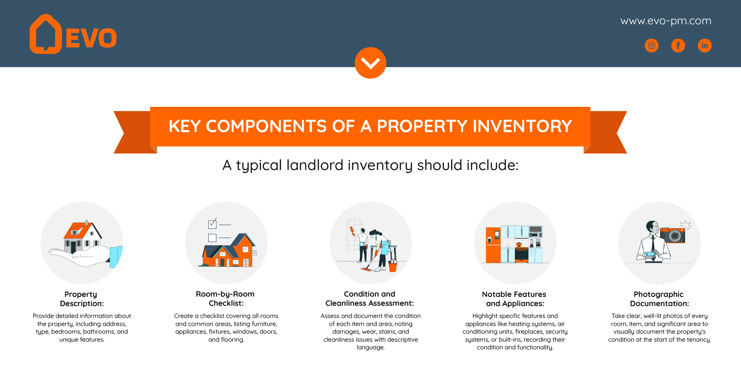
Highlights:
-
A property inventory is a detailed record of the condition and contents of your rental unit at the beginning of a tenancy.
-
This provides a baseline against which you can assess any damages or changes that occur during the tenancy.
-
It can also be used as evidence if you wish to claim money from the tenant’s deposit for repairs.
-
There is no legal requirement for landlords to have a property inventory.
-
You can make a property inventory yourself, but it is often better to pay a letting agency or independent inventory clerks.

Sooner or later, every landlord experiences a dispute with a tenant. More often than not, these disputes involve disagreements over who should pay for damage at the end of a tenancy.
To stand any chance of claiming money for repairs from a tenancy deposit, you must provide evidence of this damage.
That’s where property inventories come in. They allow you to prove the condition of your property before and after the tenancy.
If you’re a new landlord and need help understanding what a property inventory is, you’re in the right place.
This guide explains everything you need to know, including what a rental property inventory is, how it fits into the deposit claims process, how to create an inventory, the importance of storing digital copies, and how platforms like EVO can help you manage repairs following a claim.
What Is a Property Inventory?

A property inventory - sometimes called a landlord inventory - is a detailed record of the condition and contents of your rental unit at the beginning of a tenancy.
It usually consists of a long list of all elements of the property. Each of these is accompanied by a written description and one or more images of its condition when the last tenancy began.
When the tenant moves out, the condition of each element is reassessed and new pictures are taken.
This provides a baseline against which you can assess any damages or changes that occur during the tenancy.
It can also be used as evidence if you wish to claim money from the tenant’s deposit for repairs. By law, you need to keep your tenant’s deposit in a deposit protection scheme and you’ll need to apply to a tenancy deposit adjudicator to claim any funds from it. The adjudicator is unlikely to accept your request without any evidence.
Are property inventories compulsory?
No law says you must have an inventory for your property. However, the Renters Reform Bill was recently introduced to Parliament, and there have been calls to amend the bill and make rental property inventories a regulatory requirement. So this could change in the future.
Either way, it is still considered good practice for landlords to have a property inventory, and there are many reasons to have one. We’ll explain what they are in the next section.
How do property inventories work?
An inventory is an ongoing document. You need to have one in place before your tenant moves in. Then, when they move out you perform an inspection. This is then used as the baseline for the next tenant.
Claiming Deposit Money for Damages
The main reason to have a property inventory is to provide evidence so you can claim money from the tenant’s deposit if necessary.
Therefore, it’s important to understand how tenancy deposits work.
When your tenant first moves in they pay you a deposit. You have 30 days to transfer this money to an accredited tenancy deposit scheme. The funds are kept there for the duration of the tenancy and returned to the tenant when they move out.
If the property is damaged and you feel the tenant should pay for it then you may wish to claim money from the deposit.
To do this you need to apply to the tenancy deposit scheme. If you and your tenant agree on the damages then you simply ask for the money to be transferred to you.
Alternatively, you could send your tenant an invoice for the cost of repairs or replacing damaged items.
However, if you and your tenant disagree then you need to lodge a dispute with the tenancy deposit scheme.
Your case will be handed to an independent alternative dispute resolution service. You’ll have to provide evidence to them that the tenant was responsible for the damage. This includes photos and written records that you have of the item before and after it was damaged.
This evidence will be weighed by a deposit claims adjudicator and they will either approve or reject your request.
| 💡What is betterment? |
|
If your tenant pays to replace a damaged item then it is the value of the damaged item that they pay for, not the cost of the new item. This is known as “betterment”. For example, if your tenant breaks a washing machine that you installed last week then they will need to pay more than if they break a washing machine that is 10 years old. This is due to depreciation in the utility’s value. This will be taken into account by a deposit claims adjudicator when considering your case. |
What Are the Benefits of a Property Inventory?
Creating an inventory offers several benefits to you and your tenants:
Documentation and evidence
A landlord inventory clearly documents the property's condition at the beginning of a tenancy. It provides evidence that can be used to solve disputes or disagreements over damage.
Damage assessment
An inventory helps you accurately assess damage or wear and tear at your rental properties. It helps determine whether tenants should be held responsible for any repairs and provides evidence you can use to deduct money from security deposits.
Tenant communication
Sharing the inventory gives you and your tenant a shared understanding of the property’s condition, and helps you set transparent expectations and understand each other's responsibilities.
Legal protection
In the unfortunate event of legal proceedings, a well-prepared landlord inventory can serve as vital evidence. It helps protect landlords' interests by demonstrating the condition of the property and any changes that have occurred during the tenancy.
Efficient property management
A comprehensive inventory enables landlords to manage the property more effectively. It enables them to track the condition of furniture, plan maintenance and repairs, and keep an organised record of the property's assets.
Streamline moving tenants in or out
Having an inventory simplifies moving tenants in and out. You can quickly see what needs fixing, what needs replacing and what can be kept, and any disputes are minimised.
How to Make a Property Inventory
You have three main options when it comes to making a property inventory.
-
Do it yourself: this is the cheapest option, but it’s also more time-consuming. It also won’t be considered as reliable by the deposit claim adjudicator because it may be biased towards you.
-
Do it through a letting agent: this may also be considered biased towards the landlord and it costs money - but you won’t have to do it yourself.
-
Hire an independent inventory clerk: this option gives you the most chance of making a successful claim. However, it will cost you up to £130. You can search for a clerk by visiting the Association of Independent Inventory Clerks website.

A Step-by-Step Guide to Making an Inventory
Here’s how to make a property inventory if you decide to do it yourself.
Step 1: Equipment checklist
There are a few things you’ll need to bring with you to the property when you make the inventory. These are:
✔️Inventory template: Download or create a template for documenting the property's condition and contents. You could print this out and use pen and paper to fill it in - however, paper-based records are inefficient and prone to getting lost. We recommend using your phone or a tablet and storing the template in the cloud, where it can be accessed from any device. Google Docs or Google Sheets are good free tools you can use for this.
✔️Camera or Smartphone: Use a camera or smartphone with a good-quality camera to take clear photographs of the property. Ensure it's charged and has enough storage.
✔️Cleaning Supplies: Bring some basic cleaning supplies and a vacuum to ensure the property is clean when you take pictures.
✔️Torch: Use a torch to inspect darker areas and avoid missing details.
✔️Maintenance checklist: While you are making the inventory you should note any repairs or maintenance tasks that need attention. Take new pictures and update the inventory once the repairs have been completed.
Step 2: Schedule an inspection
You need to schedule an inspection of the property when your tenant moves out to update the inventory and check for any problems.
You need to agree with them when this will take place. Consider the following points:
🗓️Find a good time: Speak to the tenant about when the most convenient time is for them. Try to find a time when there is good daylight at the property. This will allow you to clearly see any issues there.
🗓️Give notice: By law you need to give your tenant at least 24 hours notice. However, it’s good practice to give them at least a week’s notice.
🗓️Encourage your tenant to be there: Invite the tenant to take part in the inventory inspection. This allows them to discuss any issues regarding the property's condition. It also helps ensure you agree on the property’s condition.
🗓️Allocate sufficient time: It can be easy to underestimate the amount of time you need to perform the inspection. Think about how long you will need to assess a room, fill in the inventory and take photos. Now multiply that time by the number of rooms and areas at the property.
Step 3: Conduct the inspection
Try to be systematic when conducting the inspection. This ensures that nothing is missed.
✔️Begin by inspecting the exterior of the property
✔️Move through each room and note the general condition and any damage
✔️If the property is furnished then do the same for items of furniture
✔️Check all appliances and equipment are working properly
✔️Examine windows, fixtures and doors
✔️Take detailed photos of everything and use multiple angles
💡Pay attention to detail |
It’s easy to walk through a room and simply glance around. However, doing this risks missing important details that may later prove critical. Take time to be thorough. For example, lift rugs, look behind furniture, and test individual plug points and window fixtures. |
Step 4: Date and sign
The final stage is to produce a report of your findings. This is called a check out report. Create copies for you and your tenant to date and sign all elements listed on the inventory, to show you agree on their condition.
You should keep one copy of the inventory for yourself and send one to the tenant.
Step 5: Repeat for new tenants
Before your new tenants move in, provide them with a copy of the inventory. On the day they move in, talk them through it and ask them to check that they agree with everything in it.
Ask them to sign and date it. This is called the check in report, and it’s what the property’s condition will be assessed against when the tenants move out.
💡Pro Tip: Store Your Inventory in the Cloud
Having a digital copy of your landlord inventory stored on the cloud is incredibly helpful.
Here’s why:
👍Accessibility: You never know when you might need to access your inventory. For example, say you get a call from a tradesperson informing you that something at the property is damaged. If your inventory is stored on the cloud then you can quickly use your phone to check what condition it was in at the last inspection. This may help you decide what steps to take.
👍Better organisation: If you own multiple properties then finding the right inventory can be challenging. Using cloud storage, you can create clear storage folders that help you quickly locate the documents you need.
👍Easy replication and distribution: Sharing a document online is far easier than printing and sending copies. And tools like DocuSign allow you and your tenants to sign them digitally.
👍Easy access for tenants: Storing your inventory and other documents online also means that your tenants can access them from their mobile device. This saves them contacting you to ask for another copy.
👍Digital back up: Storing backups in cloud-based services safeguards your records from potential disasters like hardware failure.
EVO’s platform allows you to store all tenancy documents digitally - including your inventory - so they are available to you and your tenant whenever you need them.
Manage Property Repair and Maintenance with EVO
Having a thorough property inventory will save you money and hassle. But it won’t help you ensure that the repairs themselves are completed efficiently.
That’s where EVO comes in.
Our easy-to-use digital solution transforms the way you manage your repairs and maintenance by better connecting you to your tenants and tradespeople.
It takes the hassle out of running your properties by ensuring that any repairs required at the end of a tenancy can be carried out quickly and with minimal fuss, ready for the new tenant to move in.
Our platform features:
-
Online dashboard: All your people, places, repairs, and service history in one place, with a real-time calendar, messaging, and secure document storage.
-
Helpdesk: There to help with all repair and planned maintenance needs fast.
-
Repairs: Certified trades available 24 hours a day, ensuring a fast response and quality workmanship.
-
Reminders: Ensuring nothing falls through the cracks.
-
Service history: All jobs and services are logged and easily accessible, with completion notes and images.
-
Compliance: Gas safety compliance, electrical testing and more, with digital records and service reports all in one place.
-
Emergency cover: Providing trustworthy 24/7 emergency services in case of serious issues.
Get in touch to find out how we can help you manage your inspection and repairs more effectively.

